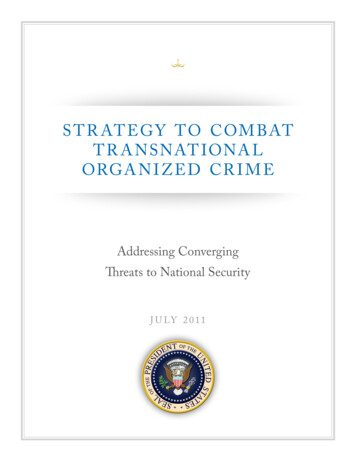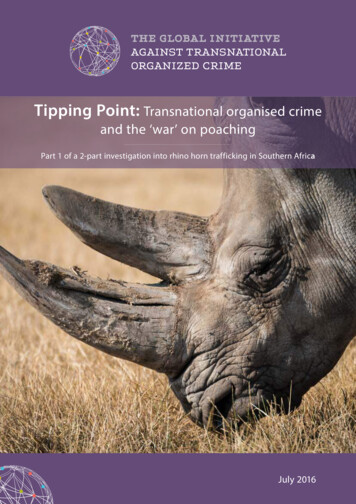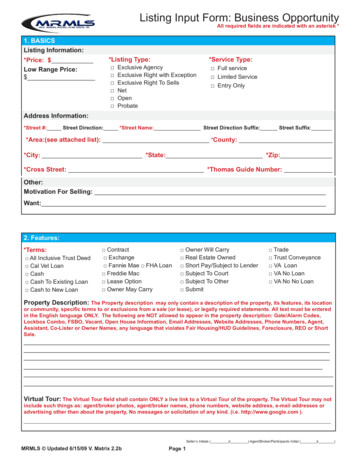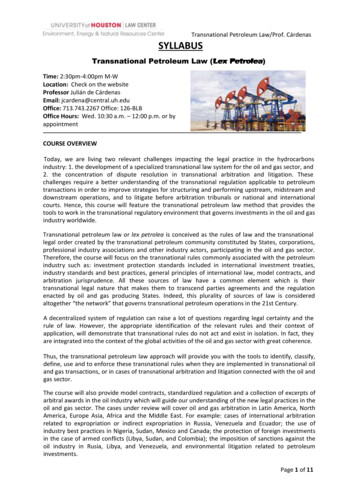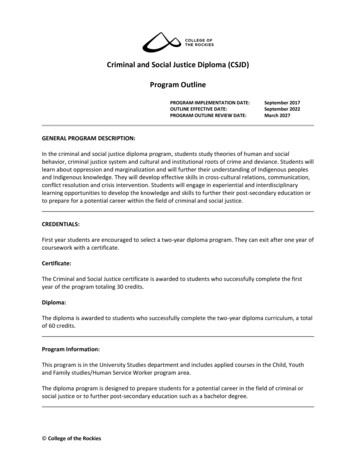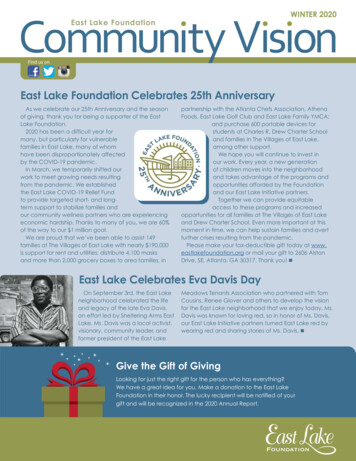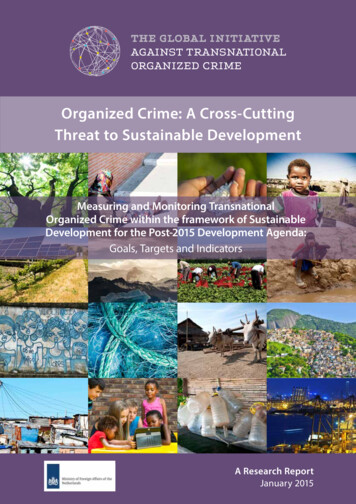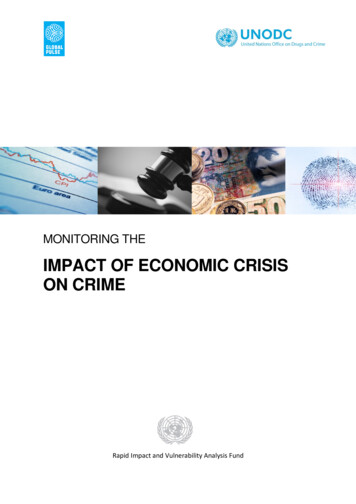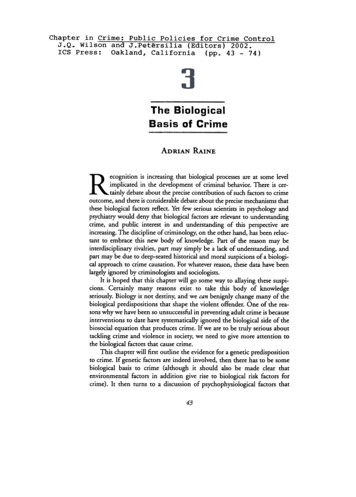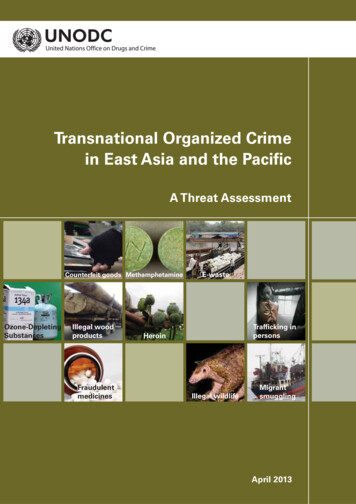
Transcription
Transnational Organized Crimein East Asia and the PacificA Threat AssessmentCounterfeit goods MethamphetamineOzone-DepletingSubstancesIllegal woodproductsFraudulentmedicinesE-wasteTrafficking inpersonsHeroinIllegal wildlifeMigrantsmugglingApril 2013
Copyright 2013, United Nations Office on Drugsand Crime (UNODC).Cover photos: www.sxc.hu (medicines),WWF-Malaysia/S.Hogg (pangolin) and CBSA(migrant smuggling).APPRECIATIONUNODC gratefully acknowledges the financial contribution of the Governments of Australia and NewZealand towards the cost of preparing this TOCTA.UNODC also acknowledges the kind contributionof the United Nations Environment Programme tothe development of the chapters 9 and 10 of thispublication.The preparation of this report would not have beenpossible without the data and information reportedby governments to UNODC and other internationalorganizations. UNODC is particularly thankful togovernment and law enforcement officials met in theregion while undertaking research.ACKNOWLEDGEMENTSThis study was conducted under the responsibilityof the UNODC Regional Office for Southeast Asiaand the Pacific (ROSEAP), Division for Operations(DO), with research support of the UNODC Studiesand Threat Analysis Section (STAS), Division forPolicy Analysis and Public Affairs (DPA).EDITORIAL AND PRODUCTION TEAMThe TOCTA EAP was produced under thesupervision of Aldo Lale-Demoz, Director, DO,and Gary Lewis, the former UNODC RegionalRepresentative, ROSEAP.Core team:In Bangkok: Mark Harris (Lead Researcher), AkaraUmapornsakula (Maps and Images), Inshik Sim,Janeille Thompson, Tun Nay Soe, Shawn Kelley,Giovanni Broussard, Sebastian Baumeister, JonathanHampshire, Stefan Wetzel, Patrick Anderson,Francesco Salonia, Louise Truslove, Angelica Boyle,Craig McFarlane.In Vienna: Jenna Dawson, Thomas Pietschmann,Louise Bosetti, Suzanne Kunnen, Kristina Kuttnig,Anja Korenblik.In New York: Ted Leggett.Writers, consultants and contracted agencies:Note: Because of significant re-writes and inputsfrom other sources, the final chapters do notnecessarily reflect the work of the original drafters.UNODC thanks all writers, consultants andcontracted agencies for their contribution.Chapter 1 (Migrant Smuggling and HumanTrafficking): Rebecca Powell with additional inputsfrom Rebecca Miller on migrant smuggling.Chapter 2 (Human Trafficking): Rebecca Powell.Chapter 3 (Migrant Smuggling): Rebecca Miller.Chapter 4 (Migrant Smuggling): Rebecca Miller.Chapter 5 (Heroin): Jianhong Liu (Prof.), HuangKaicheng (Prof.), Jieying Lin with additionalcontributions from Thomas Pietschmann(UNODC).Chapter 6 (ATS): Shawn Kelley (UNODC).Chapter 7 (Wildlife): TRAFFIC Southeast Asia andEdward van Asch. Peer reviewers: John M. Sellar(former CITES Secretariat), Ann Panoho (WildlifeEnforcement Group, NZ).Chapter 8 (Wood-based products): James Hewitt.Peer reviewers: William B. Magrath (World Bank),Jeremy Broadhead (FAO), UNEP Regional Officefor Asia and the Pacific (Bangkok).Chapter 9 (e-waste): Environmental InvestigationAgency (EIA). Peer reviewers: UNEP DITE IETCJapan; UNEP Geneva; UNEP Regional Officefor Asia and the Pacific – Compliance AssistanceProgramme (Bangkok).Chapter 10 (ODS): EIA. Peer reviewers: UNEPDITE IETC Japan; UNEP Geneva; UNEP RegionalOffice for Asia and the Pacific – ComplianceAssistance Programme (Bangkok).Chapter 11 (Counterfeit Goods): Daniel Schwartz.Chapter 12 (Fraudulent Medicines): DanielSchwartz.EXPLANATORY NOTESThe boundaries and names shown and thedesignations used on maps do not imply officialendorsement or acceptance by the United Nations.The designations employed and the presentation ofthe material in this publication do not imply theexpression of any opinion whatsoever on the part ofthe Secretariat of the United Nations concerning thelegal status of any country, territory, city or area or ofits authorities, or concerning the delimitation of itsfrontiers or boundaries.
Countries and areas are referred to by the names thatwere in official use at the time the relevant data werecollected.Since there is some scientific and legal ambiguityabout the distinctions between “drug use”, “drugmisuse” and “drug abuse”, the neutral terms “druguse” and “drug consumption” are used in this report.References to dollars ( ) are to United States dollars,unless otherwise stated.All references to “tons” are to metric tons (alsorepresented at “mt”), unless otherwise stated.DISCLAIMERSThis report has not been formally edited.This publication may be reproduced in whole or inpart and in any form for educational or non-profit purposes without special permission from thecopyright holder, provided acknowledgement of thesource is made. UNODC would appreciate receiving a copy of any publication that uses this publication as a source.The content of this publication does not necessarilyreflect the views or policies of UNODC, MemberStates, or contributory organizations, nor does itimply any endorsement.The designations employed and the presentation ofthe material in this publication do not imply theexpression of any opinion whatsoever on the part ofthe Secretariat of the United Nations concerning thelegal status of any country, territory, city or area or ofits authorities, or concerning the delimitation of itsfrontiers or boundaries.
Table of ContentsAbbreviations.iExecutive Summary.iiiIntroduction: Fighting transnational organized crime.1The flows1. Smuggling of migrants and labour trafficking within the Greater Mekong Sub-Region.52. Trafficking of women and girls for sexual exploitation within the Greater Mekong Sub-Region.153. Migrant smuggling from East and Southeast Asia to the United States and the European Union.254. Migrant smuggling from South and West Asia through Southeast Asia to Australia and Canada.375. Trafficking of opiates from Myanmar and Afghanistan into East Asia and the Pacific.496. Trafficking of methamphetamines from Myanmar and China to the region.597. The illegal wildlife trade in East Asia and the Pacific.758. Illicit trade in wood-based products from the region to the world.879. Illicit trade in electrical and electronic waste (e-waste) from the world to the region.10110. Illicit trade in ozone-depleting substances (ODS) from East Asia to the world.11311. Counterfeit consumer goods from East Asia to the United States and the European Union.12112. Fraudulent essential medicines from East Asia to Southeast Asia and Africa.129Key issues and implications for response.139Bibliography.155
mtNNCCOCOODSAcetic anhydride (precursor for manufacture of heroin)Australian Crime CommissionAnti-Counterfeiting Trade AgreementAsian Development BankAsia-Pacific Operational Drug Enforcement ConferenceAustralian Federal PoliceAnti Money-Laundering / Counter Financing of TerrorismAsia-Pacific Group on Money LaunderingAsian Research Center on MigrationAnnual Reports QuestionnaireAssociation of Southeast Asian Nations.Amphetamine-type StimulantsBusiness Monitor InternationalBillionsCanada Border Services AgencyCentral Committee for Drug Abuse Control of MyanmarChloroflourocarbonsConvention on International Trade in Endangered SpeciesCoordinated Mekong Ministerial Initiative Against TraffickingCathode Ray TubesDrug Abuse Information Network for Asia and the PacificAustralian Department of Immigration and CitizenshipEuropean CommissionEnd Child Prostitution, Child Pornography and Trafficking of Children for SexualPurposesElephant Trade Information SystemEuropean UnionElectrical and electronic wasteFood and Agriculture Organization StatisticsFinancial Action Task ForceJoint Analysis and Strategy Centre for Illegal MigrationGreater Mekong SubregionHydrochloroflourocarbonsHuman immunodeficiency virusHuman Smuggling and Trafficking CenterInternational Drug Enforcement Committee (US supported)Irregular Maritime ArrivalsInternational Narcotics Control BoardInstitut National de la Statistique et des Études ÉconomiquesInternational Criminal Police OrganizationInternational Organization for MigrationIntellectual property rightsInternet Service ProvidersIndustrial Technology Research InstituteLiberation Tigers of Tamil Eelam (Tamil Tigers)New Zealand Medicines and Medical Safety AuthorityMetric tonNational Narcotics Commission of ChinaOceania Customs OrganizationOzone Depleting Substancesi
RTTIPTOCTOCTA PVRS-MSRCWCOWEEEWHOWWFiiOrganization for Economic Cooperation and DevelopmentPhilippine Drug Enforcement AgencyPacific Immigration Directors’ ConferencePharmaceutical Safety InstituteRoyal Canadian Mounted PoliceRoyal Institute of International Affairs, UKRegional Intelligence Liaison Office – Asia PacificRadio frequency identificationRoyal Malaysia PoliceRound Wood EquivalentSouth African Community Epidemiology Network on Drug UseSynthetics Monitoring: Analyses, Reporting and TrendsTrafficking in PersonsTransnational Organized CrimeTOC Threat Assessment in East Asia PacificUnited Kingdom Border AgencyUnited Nations Convention Against CorruptionUnited Nations Commodity Trade Statistics DatabaseUnited Nations Conference on Trade and DevelopmentUnited Nations Development ProgrammeUnited Nations Environmental ProgrammeUnited Nations High Commissioner for RefugeesUnited Nations Inter-Agency Project on Human TraffickingUnited States Customs and Border ProtectionVoluntary Reporting System on Migrant Smuggling and Related ConductWorld Customs OrganizationWaste Electrical and Electronic EquipmentWorld Health OrganizationWorld Wildlife Fund
Executive SummaryEast Asia and the Pacific have experienced rapideconomic and social changes during the past fewdecades and faced the considerable regulationchallenges these changes create for public authorities.This report takes a look at the manner in whichcriminal enterprises have developed alongsidelegitimate commerce in recent years. Drawing onofficial statistics, academic studies, and interviewswith law enforcement officials, it attempts to outlinesomething about the mechanics of illicit trade:the how, where, when, who, and why of selectedcontraband markets affecting the region. It alsoendeavours to give the best reading of the availabledata on the size of these markets. Though the list ofcontraband markets discussed is not comprehensiveand it is impossible to quantify the value of thesemarkets with any precision, these estimates areoffered to prompt public debate on areas of greatpublic policy significance.The mechanics of trafficking are discussed for a nonexhaustive list of 12 illicit flows, which themselvesare organized under four headings:1. Human trafficking and smugglingof migrants2. Illicit drugs (heroin and methamphetamine)3. Resources (wildlife, wood products)and pollution crime (e-waste,ozone-depleting substances)4. Products (counterfeit goods,fraudulent medicines),ƵŵĂŶ ƚƌĂĸĐŬŝŶŐ ĂŶĚ ƐŵƵŐŐůŝŶŐ ŽĨ ŵŝŐƌĂŶƚƐFour of the 12 illicit flows reviewed involve humanbeings. The first two concern movement betweenthe countries of the region, one for general labourand one for sexual exploitation. The third concernsthe smuggling of migrants from the region to therich countries of the West, and the last focuses onmigrants smuggled through the region from the poorand conflicted countries of South and Southwest Asia.1. Smuggling of migrants and labourWUDI¿FNLQJ ZLWKLQ WKH *UHDWHU 0HNRQJ Sub-RegionWhile the crimes of human trafficking and thesmuggling of migrants are distinct, in the GreaterMekong Sub-Region (GMS), they are closelyinterlinked. Away from their home communitiesand in their destination countries illegally, smuggledmigrants have little basis to assert their rights asworkers, and what begins as a voluntary journeytowards a better life can descend into exploitation.Thailand is the regional labour magnet, andMyanmar in particular has contributed significantlyto its labour pool. While formal migration channelsdo exist, many migrant labourers prefer to enterThailand irregularly, this is because complyingwith the legal channels can be expensive and timeconsuming. As a result, many migrants turn tosmugglers to facilitate their entry and help themfind work. Many smugglers were irregular migrantsthemselves, and most rely on word-of-mouth topromote their services. For a fee, smugglers help themigrants cross both official and unofficial borders,either on foot, by vehicle or boat. The smugglersmake use of relationships they have built with Thaiemployers and brokers to link migrants with jobs.The majority of irregular migrants get what theycame for: employment at better wages than theycould have received at home. But sometimes theirvulnerability is exploited and they are forced to workwithout pay, under terrible conditions. While allareas of employment are vulnerable to exploitation,the fishing and seafood processing industries havegarnered much recent attention.iii
dƌĂŶƐŶĂƟŽŶĂů KƌŐĂŶŝnjĞĚ ƌŝŵĞ dŚƌĞĂƚ ƐƐĞƐƐŵĞŶƚ Ͳ ĂƐƚ ƐŝĂ ĂŶĚ ƚŚĞ WĂĐŝĮĐUNODC has estimated that just over half a millionmigrants are smuggled into Thailand annually,with the vast majority coming from Myanmar. Theamount paid for smuggling services varies accordingto the required services. Migrants from Myanmarpay the highest fees, while migrants from Lao PDRand Cambodia pay considerably less. It appearsthat around US 192 million is generated on anannual basis by smuggling migrants from thesethree countries into Thailand. Calculating the shareof these migrants who are subsequently traffickedis challenging, and is estimated at around 26,400victims per year, or around 5% of the smuggledmigrants. The amount of labour stolen from thesevictims averages US 1,260 per year, resulting in asum of US 33 million per year generated for theirexploiters.Breakdown of income generated by smugglingmigrants into Thailand annually200 0LJUDQW VPXJJOLQJ IURP (DVW DQG Southeast Asia to the United States andthe European Union160140US millionsGiven the gaps in the data, the estimates of thenumber of victims of trafficking in Thailand fromneighbouring countries (approximately 3,750) and inCambodia (approximately 275) should be consideredtentative, and demonstrative only of the order ofmagnitude of the problem. The income generatedby these 4,025 foreign victims of traffickingin Cambodia and Thailand is approximatelyUS 45,000 per victim per year, or about US 181million in gross revenues for their o PDR0Myanmar ŽƵƌĐĞ͗ hEK ĞƐƟŵĂƚĞ 7UDI¿FNLQJ RI ZRPHQ DQG JLUOV IRU VH[XDO H[SORLWDWLRQ ZLWKLQ WKH *UHDWHU 0HNRQJ 6XE UHJLRQThe sex markets of the Greater Mekong Sub-regionare based on both high levels of sex tourism andstrong domestic demand. Sex tourism from theWest is the best documented, but Asian sex touristsappear to be more numerous. The illicit market inThailand is probably the best known internationally,but markets in other countries, such as Cambodia,are expanding. If only a small minority of the sexworkers are trafficked, there are still a large numberof victims, given the sheer size of the industry.Thailand alone contains as many as 250,000 sexworkers, according to Ministry of Health estimates.Many of the victims are irregular migrants from thepoorer countries who fall into sex work with varyingdegrees of volition. Traffickers control migrant sexivworkers through debt bondage accumulated from thecost of smuggling. Remarkably, though, it appearsa small number of sex workers in Cambodia aretrafficked from the relatively affluent Viet Nam, aresult of a longstanding association between sex workand Cambodia’s ethnic Vietnamese minority. Bothsex tourists and local consumers provide demand forunderage victims, and this may be one of the drivingforces behind the trafficking.International labour migration is a longstandingtradition for many East Asian populations, of whomthe Chinese are the most numerous. The Vietnamesediaspora is also extensive, and flows from boththese countries appear to have increased since the1980s. Most of this migration is legal, but thosewho choose to migrate illegally are highly likely touse smugglers, due to the distances involved andlanguage difficulties. The main destinations forChinese migrants, who are mostly from the moreaffluent, eastern provinces of China, are the UnitedStates, France, Germany, Italy, Spain and the UnitedKingdom. The majority of Vietnamese smuggledmigrants are from the northern provinces, and tendto choose the United States, United Kingdom,France and Germany as preferred destinations.While sea routes are still used, today most smuggledChinese and Vietnamese migrants fly as close aspossible to their destinations, landing in countrieswithout visa requirements or where entry controlsare weak, and then move clandestinely the restof the way overland. Many use routes throughCentral America to reach the US-Mexico border.European authorities report that the majority ofsmuggled Chinese nationals enter by air, and useEastern Europe as the transit region of choice, with
Executive Summarya combination of genuine andQuarterly asylum claims submitted in selected industrialized regions,2009 – 2011fraudulent documentation.Transit through Africa is growing.100,000Visa and marriage fraud is alsopopular with Chinese smugglers.80,000Chinese and Vietnamese60,000smuggling networks are known to40,000outsource travel through transitcountries, as well as entry into20,000destination countries, to locally0based networks, and occasionallythere is collusion between2009 2009 2009 2009 2010 2010 2010 2010 2011 2011 2011 2011Chinese and Vietnamese migrantQ1 Q2 Q3 Q4 Q1 Q2 Q3 Q4 Q1 Q2 Q3 Q4smuggling networks. Chinesenetworks are male-dominated,Australia/NZCanada/United Statesbut women are also involved.Europe TotalEuropean Union (27)Less is known about VietnameseSource: UNHCR 2012smuggling networks, althoughrefugees or intend to claim asylum upon reachingthey are well-established throughout Europe.their destination. The focus of this chapter is on theWhile not all irregular Chinese and Vietnamesesmuggling of migrants from these regions, throughmigrants are smuggled, most are. It is estimatedSoutheast Asia, to enter Australia or Canada by sea.that approximately 12,000 Chinese irregularBoth these countries host large diaspora communitiesmigrants enter the US every year, each payingand this, along with the strong social supports theyaround US 50,000 for smuggling services. Thisoffer, makes them attractive destination countries forwould generate up to US 600 million a year forasylum seekers. Most of these smuggled migrants aresmugglers. The number of Vietnamese smuggledyoung, single males, many of who have been sent byinto the US is much lower, likely fewer than 1,000their families to put down new roots so that they canindividuals. If they pay the same fees as the Chinese,can follow.this would result in payments to smugglers beingMost are smuggled by air from their home countriesworth US 50 million a year. Smuggling fees forto transit countries from which they continueChinese irregular migrants wishing to enter theonward. Once pooled in the departure location,European Union are lower, averaging aroundmany of the migrants wait weeks or months toUS 17,000. UNODC estimates that up to 36,000board the boats, which are often in poor condition;Chinese irregular migrants use smuggling servicesseveral have sunk before reaching Australianto reach the EU on an annual basis, which wouldterritory. Indonesia is the main departure countrygenerate up to US 600 million a year. Roughly halffor smuggled migrants hoping to reach Australiaas many Vietnamese irregular migrants are detectedby boat, given its proximity to the territories ofas Chinese in the EU, suggesting a flow of aboutChristmas Island and Ashmore Reef. While Canada18,000 per year. Again, if paying the same priceis a secondary destination for asylum seekers fromas the Chinese for smuggling services, this wouldSouth and West Asia, it is the destination of choiceprovide an income of US 300 million for smugglersfor those from Sri Lanka. Most smuggled migrantseach year.reach Canada by air, but boat arrivals have increasedin recent years, including notable cases in 2009 0LJUDQW VPXJJOLQJ IURP 6RXWK DQG 2011.West Asia through Southeast Asia toAustralia and CanadaThe dynamics behind the smuggling of migrantsfrom West and South Asia are complex, as a largeproportion of these smuggled migrants are eitherMost of the migrant smuggling networks are smallor medium-sized, involving a range of intermediarieslocated throughout the departure, transit anddestination countries. Most have a hierarchicalstructure, many share ethnic backgrounds with thev
dƌĂŶƐŶĂƟŽŶĂů KƌŐĂŶŝnjĞĚ ƌŝŵĞ dŚƌĞĂƚ ƐƐĞƐƐŵĞŶƚ Ͳ ĂƐƚ ƐŝĂ ĂŶĚ ƚŚĞ WĂĐŝĮĐmigrants. They may outsource certain services intransit countries to locals in those countries. Femalesmugglers are preferred, as they attract less attentionfrom law enforcement. The smuggling networksinvolved in bringing migrants to Canada from SriLanka are closely linked to the Liberation Tigers ofTamil Eelam (LTTE).There are an average of 6,000 smuggled migrantswho attempt to reach Australia by sea every year,most of which pay around US 14,000 for smugglingservices. This generates an income for smugglersof US 85 million annually. If we take the 492smuggled migrants that arrived in Canada on theMV Sun Sea in 2010 as an average for annual arrivals,and multiply by the reported US 25,000 fee, theseoperations would generate US 12.3 million a yearfor the smugglers. ƌƵŐ ƚƌĂĸĐŬŝŶŐThe production and use of opiates has a long historyin the region, but the main opiate problem in the21st century involves the more refined form of thedrug: heroin. In addition, methamphetamine hasbeen a threat in parts of East Asia for decades (in theform of yaba tablets), but crystal methamphetaminehas recently grown greatly in popularity. Virtuallyevery country in the region has some crystalmethamphetamine users, and some populationsconsume at very high levels. 7UDI¿FNLQJ RI RSLDWHV IURP 0\DQPDU and Afghanistan into East Asia and the3DFL¿FHeroin consumption is rising in the region, with anestimated 3.3 million users at present. Today, mostof the regional heroin production is confined topolitically-contested parts of Myanmar. Almost all ofthe heroin produced in Southeast Asia is consumedin East Asia and the Pacific. It is rarely encounteredoutside the region.Since the majority of regional heroin users reside inChina, the most significant flow of heroin proceedsdirectly across the border between Myanmar’s ShanState and the Chinese province of Yunnan. Mostof this is trafficked across the border by individualcouriers, many from ethnic groups that straddlethe border. From China, a significant amountof heroin is re-exported to the rest of the region,viNational estimates of the number of heroin usersin 2010Thailand, 48,000Rep. Korea, 60,000Japan, 41,000Australia, 30,000Others, 52,000Myanmar, 100,000Viet Nam, 155,000Malaysia, 170,000Indonesia, 247,000China*, 2,366,000 ŽƵƌĐĞ͗ hEK ĞƐƟŵĂƚĞƐ Ύ /ŶĐůƵĚŝŶŐ dĂŝǁĂŶ ;WƌŽǀŝŶĐĞ ŽĨ ŚŝŶĂͿ͕ ,ŽŶŐ ŽŶŐ ; ŚŝŶĂͿ ĂŶĚ DĂĐĂŽ ; ŚŝŶĂͿpredominantly through Yunnan’s capital, Kunming.The contraband traffic between China and Myanmarflows both ways, as China is a major producer of theprecursor chemicals needed to produce heroin.Since heroin from Myanmar is no longer sufficientto meet regional demand, large volumes areimported from Afghanistan. The trafficking ofAfghan heroin into the region is more complicated,as the drug travels by land, sea and air through avariety of transit countries. The Xianjiang UyghurAutonomous region is the main distribution hub forAfghan heroin crossing into western China, whileGuangzhou is the major distribution hub for Afghanheroin nationally and for export into Southeast Asia.As Afghan heroin has become more important tolocal markets, Nigerian and Pakistani groups haveentered the market. Malaysia is frequently usedas a hub to redistribute the drug to the rest of theregion. International drug syndicates have recruitedCambodian, Indonesia and Thai nationals tosmuggle the heroin, mostly by air.There is a lack of reliable data on the prevalenceof heroin use in the region, and little is knownabout how much users consume. Based on the bestreading of the available data, regional consumptionis estimated at 65 tons of pure heroin in 2011.Available data on prices and purity suggest a retailsales volume of about US 16.3 billion in 2011. 7UDI¿FNLQJ RI PHWKDPSKHWDPLQHV IURP 0\DQPDU DQG &KLQD WR WKH UHJLRQConsumption of pill-form methamphetamine(“yaba”) remains very popular in Southeast Asia,particularly Thailand. Much of the world’s yaba is
Executive Summaryprominently in methamphetamine markets in EastAsia and the Pacific.produced in Myanmar’s Shan State, as well as inChina. Crystal methamphetamine, a more potentand addictive form of the drug, has spread to everycountry in the region. China is probably the largestproducer, but large labs have also been detected inIndonesia and the Philippines. Use of crystal methin Oceania and the Greater Mekong Sub-regionis the highest in the world, and in parts of China,methamphetamine has begun to displace heroinas the most problematic drug of abuse. Increasingmethamphetamine use is also of concern in thePacific Islands, which do not have the resources tocombat the problem. Many of the Pacific Islands arealso used as transhipment hubs, but production hasbeen noted in Fiji, Guam and French Polynesia.The yaba market is largely confined to the GreaterMekong Sub-region. Based on seizure and surveydata, an estimated 1.4 billion yaba pills are consumedannually. Using local prices, this market generatesUS 8.5 billion each year. Calculating volume andvalue of the crystal methamphetamine marketis trickier, given the large numbers of countriesproducing and consuming the drug. The estimatednumber of users in East Asia and the Pacific isaround five million, with China and the Philippinesaccounting for much of this total. Based on streetprices in the region, the crystal methamphetaminemarket is worth US 6.5 billion. Taking yaba andcrystal together, the methamphetamine market inEast Asia and the Pacific generated around US 15billion in 2010.China and Myanmar stand out as producers forexport. In Myanmar, methamphetamine productionis strongly associated with non-state armed groups,which are actively participating in the manufactureand trans-border smuggling of the drug. AsMyanmar has no domestic pharmaceuticals industry,all the precursor chemicals required are divertedfrom neighbouring countries. In China, mostproduction is consumed domestically, but both Japanand the Republic of Korea say that most of theirmethamphetamine comes from China.ZĞƐŽƵƌĐĞƐResource-related crimes include those related to bothextractive industries, such as the illegal harvestingof wildlife and timber, and other crimes that havea negative impact on the environment, such as thedumping of e-waste and the trade in ozone-depletingsubstances. In all cases, the threat goes beyondborders, jeopardizing the global environmentalheritage. These are therefore crimes of inherentinternational significance, though they are frequentlydealt with lightly under local legislation.A wide range of players are involved in the domesticand transnational methamphetamine markets,including professional criminals, high-rankingofficials and military personnel in several countries.Ethnic Chinese networks have been complicit inmethamphetamine markets inside Myanmar, aswell as in Indonesia, Malaysia and the Philippines.Nigerian and Iranian criminal networks also feature7. The illegal wildlife trade in East AsiaDQG WKH 3DFL¿FShare of the adult population that used methamphetaminein 20103.002.712.502.13 2.10 2.102.001.581.40 1.39 1.35 1.321.501.161.000.60 0.60 0.550.350.500.25 0.22 0.220.20.18 0.12 ŽƵƌĐĞ͗ hEK ĞůƚĂ ĂƚĂďĂƐĞRep of KoreaJapanIndonesiaMyanmarBrunei D.Viet NamMalaysiaHong Kong (China)CambodiaTaiwan (China)N. Mariana Is.GuamAmerican SamoaLao PDRThailandPalauAustraliaNew ZealandPhilippinesMarshall Islands0.00In East Asia, population growth andburgeoning affluence have led to risingdemand for exotic and luxury products,including wildlife products. China isboth the region’s largest economy andthe largest consumer market for wildlife,imported for food, traditional medicinalingredients, the pet trade, and exoticdécor. A wide range of animal and plantproducts are imported, including thosederived from protected species of bear,pangolin, reptiles, turtles, sharks, corals,aquarium fish, and other marine wildlife.Each of these products has a differenttrading chain, which may includedomestic and international specialistsvii
dƌĂŶƐŶĂƟŽŶĂů KƌŐĂŶŝnjĞĚ ƌŝŵĞ dŚƌĞĂƚ ƐƐĞƐƐŵĞŶƚ Ͳ ĂƐƚ
Chapter 8 (Wood-based products): James Hewitt. Peer reviewers: William B. Magrath (World Bank), Jeremy Broadhead (FAO), UNEP Regional Office . APG Asia-Pacific Group on Money Laundering ARCM Asian Research Center on Migration . WWF World Wildlife Fund. iii East Asia and the Pacific have experienced rapid
